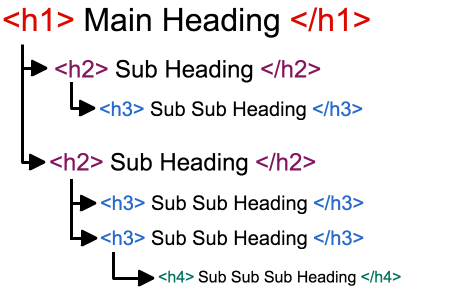Heading Tags

As the name suggests, heading tags are used to write the heading of a page. It is a top-down hierarchy of six tags; from <h1> to <h6>. The most significant is the <h1> heading tag as it holds the title of a post. It is further followed by h2, h3, and so on up to h6 tag. The h1 tag has a boldest font size and h6 has the least as compared to all other heading tags.
Heading tags play a vital role in both HTML (Hypertext Markup Language) and SEO (Search Engine Optimization). These tags give structure to your website pages giving it a user-friendly attribute. Further, it helps in categorization of content that helps the search engine in indexing the content and structure of website. It refines the structure of web document.
All six headline tags play a significant role while writing HTML content. It brings organization in the content making it an easy go through site. Along with HTML, it also supports SEO.
How Headline Tags Help SEO?
While crawling your website pages, search engine tries to figure out the following questions about your page: –
Q1. What the web page is about?
Q2. How relevant it is?
Search engines perform on page analysis to find the answer to first question i.e., you’re your web page is about. And, when it comes to figuring out the relevancy and how good it is as compared to other similar websites, links play a major role. Links to a page is the basis of judgement of the quality.And, one out of many things that search engines consider determining the quality of website content is the words used in the heading tags. Thus, it is important to include your keywords in the headline tag.
Role of Headline Tag
Before we go on using a product, we always have a sight on its benefits. Walking the same path, let’s first look at some major advantages of using headline tags in your web pages.
1.) Bring Organization in Content
It brings clarity to a content.Using headline tags in your content gives it a hierarchical organization. This avoids writing long, unbroken paragraphs that are too messy to read and hold a reader’s interest. Headline tags make the content organized and allow the reader to easily understand how different sections are related.
2.) Create Hierarchy

With six headline tags of decreasing value, a good hierarchy can be presented in a content. This makes headings and subheading shine clearly. A single page content can be made more interesting by differentiating titles, headings and sub-headings. The <h1> tag holds the main title of the content, <h2> tag holds the headline for major sections and <h3> tag can be used for the subsection headings and so on. It gives a clear outline to the content.
3.) User-friendly Outlook
Majority of the visitors don’t read every single word of an online content. What they do is skin the main points to find what they are looking for. This is a general practice that you don’t have control on. But what you can do is, offer a good outline to your content. As when a reader finds a well distributed content, it doesn’t make the reader annoyed of the seamless content making way into the line of the article. Headline tags make the content more digestible.
4.) Facilitate Linking

You can allow links to your page by adding “id” to headline of the page. Any element on a page can be linked using a hash-sign “#” or “id”. It creates in-document links that are really helpful in enhancing the quality of your content as you provide reference content.
Using Headline Tags for SEO

Now, when you know why headline tags are significant let’s move on to the usage part i.e., How to use headline tags in your content to increase the SEO value.
The headline tags are defined as: –
<h1>Text</h1>
<h2>Text</h2>
<h3>Text</h3>
<h4>Text</h4>
<h5>Text</h5>
<h6>Text</h6>
Fulfill the purpose of headline tag.
The purpose of headline tag is to categorize the content and give a better insight into the information presented. It makes a page more user-friendly and instantly gives idea to the reader about the website by going through the sub-headings.

As for <h1> tag, it is the main tag that holds the title of a page. So, while using <h1> tag it is crucial to include words and phrases that give an idea of the page content by just looking at the headline.It should be descriptive within the word limits.
Give hierarchy to your page.

It is important to maintain hierarchy on your web page and make the right use of headline tags to give value to SEO of your website. The descending order of tags start from <h1> and goes down to <h2>, <h3>, and so on up to <h6>.
Include Keywords in headline tag.
Keywords are integral part of SEO. While writing headlines for your page, do a thorough research on keywords relevant to the web page content. Categorize these keywords based on their relevancy into focus, primary, secondary keyword and tertiary keywords. The focus keywords are the main keywords that you need to include in the <h1> tag and meta tag of the webpage.
Frequency of <h1> tag.

In classic HTML, only one <h1> tag was recommended per web page. Designers used to include <h1> tag for their website logo and used <h2> tag for the main headline of the page. This decreased the SEO value of the web page. Now, multiple h1 tags can be used on a single web page as the requirement demands.
How to Use H1-H6 Tags Appropriately in Your Content?
There are six heading elements, starting from h1 (the most significant) and ending at h6 (the least significant). The use of heading tags descends down from h1 tag and the order of headings should not skip levels, however, it is not constrained. Heading tags pose an impact on the ranking of a page as Google use heading tags in SEO.
Points to be kept in mind while using heading tag: –
- Include keywords in <h1> tag but avoid keyword stuffing.
- Use only one h1 tag per page.
- You can use any number of h1, h2, h3, h4, h5 & h6 tags for sections and subsections in a single page.
- Do no skip the heading levels i.e., descend down stepwise, h1 through h6. Always remember that the equal or higher-level headings start a new section whereas lower level headings start a new subsection.
- Use h1 tag for main heading and h2-h6 tags for sub-headings of the page.
- Don’t use same lines for both h1 tag and page titles.
- Make your heading tag relevant to the page content.
- H4 tag is great to use for content in the sidebar and footer.
How to Structure Your Content Using Heading Tags?
The basic purpose of using headline tag is to give structure to your content. But the question is, how to structure it? Let’s find out the answer.
Typically, there are two ways to present a content on a page; single piece of content on a pageor bunch of content on a page (index page).The later includes the main blog page, categories, author pages and so on. Also, there is content on the sidebars and footers of a site page. Using headline tags in an appropriate manner for all these situations can affect SEO.

Main Headline and Section Headlines – Use of H1 &H2 tag
For single content pages, the title is written in the <h1>tag and sections within <h2> tags.
For Example: –
<main><article>
<h1>Digital Marketing</h1>
<h2>SEO</h2>
<h2>SEM</h2>
<h2>PPC</h2>
</main></article>
For index pages, the site title is put in <h1>tag and further the titles of all subsequent pieces of content are put in <h2> tag.
For Example: –
<main>
<h1>Digital Marketing</h1>
<article><h2>SEO</h2></article>
<article><h2>SEM</h2></article>
<article><h2>PPC</h2></article>
</main>
Subsections and Sidebar – Use of H3 &H4 tags
The headline tags <h3>&<h4> are commonly used for subsections and for widget titles in the sidebars respectively. Most of the content management systems will automatically do this for you.
Headlines Supported by Browser – H1 to H6 tags
All the browsers, be it Internet Explorer, Google Chrome, Mozilla Firefox, Opera etc., support all the headlines from H1 to H6.
About This Page
what are heading tags, what is the use of heading tags, how heading tags affect SEO, use of heading tags for SEO, what is h1 tag, h1 tag for seo, how to use h1 tag for good seo performance, h2 tag, cout of h1 tag in one page, what is the total no. of heading tag, Main Headings Use of H1 &H2 tag

Author Sachin Gupta - Digital Marketing Consultant
Website: www.sachingupta.in
Read More: About Sachin Gupta








